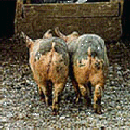Manure Pit Hazards is one of the chapters from Lessons in Farm Safety, an interactive curriculum used to teach children about farm safety. Lessons in Farm Safety was developed by the Farm Safety & Health Program team at the University of Minnesota.
BACKGROUND
Farm
workers risk their lives every time they enter a manure
pit. The oxygen-deficient, toxic, and /or explosive atmosphere
which can develop in a manure pit has claimed 12 lives
in Minnesota since 1994. Unfortunately, this is not just
an "adult" problem; three of the twelve fatalities in
Minnesota were of children under six years of age. This
lesson reviews the reasons farmers use manure pits, common
and dangerous gases found in manure pits, and how a person can be safe when working in and around manure pits.
LEARNING
OBJECTIVES
By
the end of this lesson the learner will:
ACTIVITIES
Tell
students the purpose of manure pits. Manure pit systems,
used primarily on swine and dairy farms, allow for the
easy cleaning of animal confinement buildings and efficient
underground storage of large amounts of raw manure. Because
the dangerous pit gases may not always be present, farm
workers may have successfully entered these pits in the
past.
Invite a respiratory therapist to speak to the group about how the lungs function and the symptoms of respiratory disease. Good visual aids include respiratory protection devices, Use Manure Pit slide set (see resources) or review the properties of gases that may be found in manure pits.
Set up manure pit display (directions follow). Demonstrate displacement of oxygen by toxic gases by lighting match and slowly lowering it into the tank (wrap a coated wire bread twisty around the match to lower it through the slats). The flame will quit burning within a few inches, well above the visible layer of gas. If you allow a few minutes for the gases to accumulate the flame will burn out just beneath the slatted floor. This will reinforce the concept that gas s necessary to breath (or allow a flame to burn) are invisible and can fill a manure pit. Be sure to emphasize that a person should NEVER enter a manure pit with a lit match.
Search the internet for manure pit web sites. A good place to start might be the University of Minnesota's manure education and research page.
HOW
TO MAKE A MANURE PIT DISPLAY
You
will need one of each of the following items: 2½ gallon
aquarium; toy cow, pig, and bull (1/32 scale); one pound
of dry composted manure or dark soil; screen trim (any
other thin wood will also work); gray spray paint; glue;
Manure Pit posters (see resources); water; matches; and
dry ice (pellets, not blocks); gloves to handle dry ice;
and chocolate stars or kisses to simulate manure on top
of floor (optional).
WARNING! : Dry ice is extremely cold and may cause severe burns in contact with skin. It also liberates heavy gas which may cause suffocation. Do not enter confined areas where dry ice is used or stored until adequately ventilated. Do not taste. Do not put in stoppered glass jars or other sealed containers. Handle with gloves. Keep out of children's reach.

ADDITIONAL
RESOURCES
WHAT
ARE MANURE PITS AND WHY ARE THEY DANGEROUS? (PowerPoint
slide set) Description:
Interactive slide set that can be made into any size posters
from a disk or used with a slide projector. Covers reasons
for using manure pits, common gases present in pits, reasons
some Minnesota farmers have entered pits (and died), correct
way to enter pit, and what to do if someone has fallen
into a pit.
PC compatible disk in .ppt format available for $3.00. You will need to have Microsoft PowerPoint software on your computer to use the disk. Photographic slides available for $15.00. Order from: Farm Safety and Health Program, Biosystems & Agricultural Engineering Department, University of Minnesota, 1390 Eckles Ave., St. Paul, MN 55108-6005. Make check payable to the University of Minnesota. An alternative method of viewing the PowerPoint slides is to go directly to the slides:
The Poop About Manure
Disclaimer and Reproduction Information: Information in NASD does not represent NIOSH policy. Information included in NASD appears by permission of the author and/or copyright holder. More